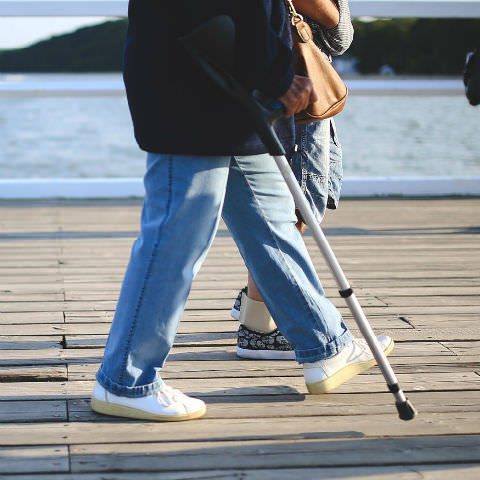You want to maintain your independence, but mobility issues can get in the way. Fortunately, a walking aid can help to improve your mobility both at home and on the go. Our overview of walking aid options will help you choose the right option for your needs. This could help to improve your quality of life.
Getting Around Safely
Many of us struggle with our mobility in one way or another, whether that be simply moving around the house or needing some support on longer walks with family and friends. Using walking equipment to combat these mobility issues has a multitude of advantages including support with stability, balance, and weight distribution, resulting in less falls and accidents. As a result, they can help to support your independence.
Walking aids can be used in many different situations. You may find that you need a walking stick in the house but require a walking rollator or wheelchair when travelling longer distances. You may only require a walking aid for a short time if you are recovering from an injury or illness, or may require a longer term option.
You will also need to consider your living space and make adjustments depending on the equipment.
- • Rugs and cluttered floors can be dangerous, so move potential hazards.
- • Some walking aids should not be used on wet floors, so you will need to consider what type of support you require in the bathroom.
- • If you have stairs in your property, you will need to think carefully about walking aids, as using walking frames on stairs can be dangerous.
Most importantly, make sure that you feel safe and comfortable using the equipment that you choose. Your doctor or physiotherapist will be able to advise you on the best option for you. We have summed up the most popular choices below:
Walking Sticks
A popular choice is the walking stick. This is usually the best option for those with moderate balance issues and can be a great help to get around safely and more confidently. You can also use two sticks if you find it particularly difficult to balance.
Walking sticks come in various shapes and sizes to suit the user. Handles can vary from a traditional crook-shape to swan-necked variety which can be slightly more comfortable. It is also useful to use a wrist strap in order to secure the stick whilst it’s not in use.
Another useful option is the folding walking stick, which can be easily stored away in a shopping bag or in the car.
For more support, you can opt for a three or four-footed walking stick. Some sticks also have a foldaway seat attached allowing you to sit and rest on longer walks.
Crutches
Crutches can often feel stronger and more secure than walking sticks and are useful for a shorter time period after a fall or accident. Crutches allow you to put more weight on your arms and relieve some pressure from your legs. This can help to relieve pain in leg joints. However, if you develop a longer-term mobility issue, we would recommend using one or more of the other walking aids we have listed.
Walking Frames
A walking frame provides more support than a stick or crutch. Modern versions can be folded up for easy storage.
There are two types of walking frames: wheeled and non-wheeled. Non-wheeled varieties require reasonable arm strength as the frame has to be lifted every time you step. Whilst wider bases are generally sturdier, they are also more difficult to store so consider this when opting for walking frames.
A walking frame with wheels (or a rollator) requires less arm strength and those with three or four wheels simply have to be pushed. A two-wheeled frame has wheels at the front; the back two legs are lifted whilst the front two roll forwards.
Mobility Scooters
If you need to head down to the shops but can’t handle the walk, a mobility scooter can make it easier to get where you need to go. With a mobility scooter, you can save your energy for walking around the shop itself rather than struggling along the paths and needing to sit down along the way. Alternatively, there is enough space in most supermarkets for you to drive your mobility scooter along the aisles.
A mobility scooter is the ideal walking aid for getting out of the house. They help you conserve energy for other activities, and help you spend more time outdoors. However, they are amongst the most expensive walking aid options, so be sure to shop around for a good deal.
How to Get a Walking Aid
It is always best to get professional advice before using a walking aid. You may be able to get referred for an assessment from your GP or local social services. A physiotherapist or occupational therapist will then advise the best equipment for you. They may then provide you with equipment free of charge or advise you what and where to purchase.
You can obtain walking aids privately without assistance, but may purchase badly fitted or incorrectly sized equipment that can impact your mobility further. It is always recommended that you trial equipment before buying to make sure that it suits you and your lifestyle.
Sources come from DLF and Which
Our Mission
Telecare Choice provide personal alarms for elderly, disabled, and vulnerable people so that they can remain safe and secure in their own homes. A personal alarm allows you to request help at the press of a button. When the alarm is activated, our Monitoring Team speak to you through the loudspeaker to find out what support is needed. They then inform emergency contacts and, if necessary, the emergency services.
You can find out more about Telecare Choice alarms by reading our quick guide. Order your Telecare Choice personal alarm today.
Editor’s Note: This article was updated on 21st November 2023 to reflect current information.




